Top 10: Facts about the Morgan Super 3
Morgan has launched the all-new Super 3, the company’s latest three-wheeled model. Here are ten things worth knowing about it:
1. The Super 3’s styling is inspired by the jet age
Whereas the now-superseded 3 Wheeler had a distinctly 1920s vibe, the design of the Super 3 is influenced by the mid-20th century jet age. Accordingly, form follows function, both in terms of aerodynamics and packaging.
Notable features include rectangular diffuser plates on each side. Termed ‘sideblades’ by Morgan, they not only cover the radiators, but they also provide a mounting point for various accessories.
2. There’s no separate chassis
The Super 3 is built around a three-part bonded aluminium monocoque. It’s constructed using Superforming, a technique which involves heating aluminium to a superplastic state before creating shapes through vacuum forming.
In the interests of weight, rigidity and interior space, the exterior body panels are stressed, too.
3. Practicality should be good enough
An IP64 rating means all parts of the cabin are protected against dust ingress and water splashes. Furthermore, the upholstery line-up comprises vinyl, water-resistant leather, enhanced-durability saddle leather, and a technical fabric with water- and UV-resistance properties.
Luggage is carried within the rear clamshell boot, or above it on an optional rack. If extra capacity is needed, then numerous panniers and racks can be attached to the aforementioned sideblades.
Of course, a Super 3 is permanently open to the elements, but a footwell heater and taller wind deflector screens are available to help combat the effects of adverse weather.
4. Plenty of customisation choices are being offered
Morgan has developed a selection of more than 200 options and accessories, so achieving a unique look will be easy.
Among them are a range of items that are the result of a collaboration with Malle London. For example, the Morgan x Malle panniers are made from 18oz waxed black canvas, and they even incorporate cup holders.
5. Ford supplies the engine
Gone is the V-twin motorcycle engine of the Morgan 3 Wheeler. Instead, the Super 3 is powered by a Ford 1.5-litre, three-cylinder, naturally-aspirated unit.
Maximum output is 118 PS (116 bhp / 87 kW) at 6,500 rpm, while 150 Nm (110 lb-ft) of peak torque arrives at 4,500 rpm.
6. That engine isn’t exposed
Unlike the 3 Wheeler, the Super 3’s motor sits behind the front axle line, concealed beneath a cowling. One of the obvious benefits of such an arrangement is improved weight distribution.
A mesh section still allows a view of the moving mechanicals, though.
7. Mazda supplies the gearbox
One component carried over from the 3 Wheeler is the Mazda five-speed manual transmission.
8. Performance is better than before
Thanks partly to a dry weight of just 635 kg (1,400 lb), the provisional 0-62 mph (100 km/h) time and top speed are 7.0 seconds and 130 mph (209 km/h) respectively.
However, efficiency isn’t outstanding, as combined cycle fuel economy is 40.0 mpg (7.1 l/100km) and CO2 emissions are 130 g/km.
9. Pricing has already been announced
A Super 3 costs from £34,958.33 excluding local market taxes.
For the UK, that figure translates to a starting price of £41,995, plus on-the-road charges.
10. Deliveries begin this year
Super 3 customer orders are already being accepted.
Deliveries are scheduled to go first to European territories in June 2022, followed shortly thereafter by the USA, and then other countries.
Related post:
P101 marks the end of the Morgan 3 Wheeler
1. The Super 3’s styling is inspired by the jet age
Whereas the now-superseded 3 Wheeler had a distinctly 1920s vibe, the design of the Super 3 is influenced by the mid-20th century jet age. Accordingly, form follows function, both in terms of aerodynamics and packaging.
Notable features include rectangular diffuser plates on each side. Termed ‘sideblades’ by Morgan, they not only cover the radiators, but they also provide a mounting point for various accessories.
2. There’s no separate chassis
The Super 3 is built around a three-part bonded aluminium monocoque. It’s constructed using Superforming, a technique which involves heating aluminium to a superplastic state before creating shapes through vacuum forming.
In the interests of weight, rigidity and interior space, the exterior body panels are stressed, too.
3. Practicality should be good enough
An IP64 rating means all parts of the cabin are protected against dust ingress and water splashes. Furthermore, the upholstery line-up comprises vinyl, water-resistant leather, enhanced-durability saddle leather, and a technical fabric with water- and UV-resistance properties.
Luggage is carried within the rear clamshell boot, or above it on an optional rack. If extra capacity is needed, then numerous panniers and racks can be attached to the aforementioned sideblades.
Of course, a Super 3 is permanently open to the elements, but a footwell heater and taller wind deflector screens are available to help combat the effects of adverse weather.
4. Plenty of customisation choices are being offered
Morgan has developed a selection of more than 200 options and accessories, so achieving a unique look will be easy.
Among them are a range of items that are the result of a collaboration with Malle London. For example, the Morgan x Malle panniers are made from 18oz waxed black canvas, and they even incorporate cup holders.
5. Ford supplies the engine
Gone is the V-twin motorcycle engine of the Morgan 3 Wheeler. Instead, the Super 3 is powered by a Ford 1.5-litre, three-cylinder, naturally-aspirated unit.
Maximum output is 118 PS (116 bhp / 87 kW) at 6,500 rpm, while 150 Nm (110 lb-ft) of peak torque arrives at 4,500 rpm.
6. That engine isn’t exposed
Unlike the 3 Wheeler, the Super 3’s motor sits behind the front axle line, concealed beneath a cowling. One of the obvious benefits of such an arrangement is improved weight distribution.
A mesh section still allows a view of the moving mechanicals, though.
7. Mazda supplies the gearbox
One component carried over from the 3 Wheeler is the Mazda five-speed manual transmission.
8. Performance is better than before
Thanks partly to a dry weight of just 635 kg (1,400 lb), the provisional 0-62 mph (100 km/h) time and top speed are 7.0 seconds and 130 mph (209 km/h) respectively.
However, efficiency isn’t outstanding, as combined cycle fuel economy is 40.0 mpg (7.1 l/100km) and CO2 emissions are 130 g/km.
9. Pricing has already been announced
A Super 3 costs from £34,958.33 excluding local market taxes.
For the UK, that figure translates to a starting price of £41,995, plus on-the-road charges.
10. Deliveries begin this year
Super 3 customer orders are already being accepted.
Deliveries are scheduled to go first to European territories in June 2022, followed shortly thereafter by the USA, and then other countries.
Related post:
P101 marks the end of the Morgan 3 Wheeler


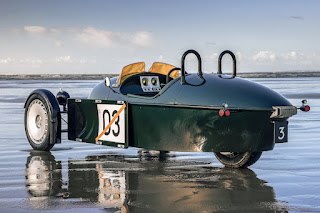
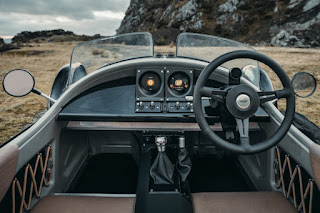
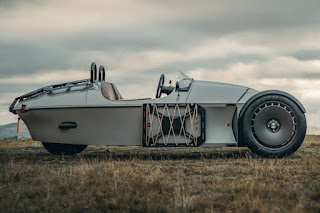


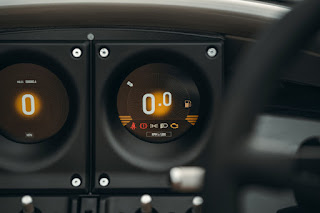
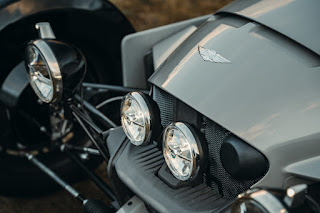
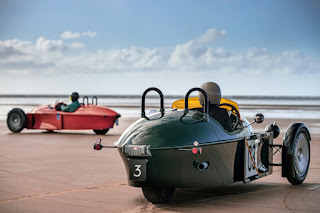
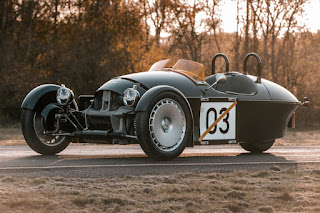

%2BDashboard.jpg)

+Front+Side.jpg)

+Front+Side.jpg)

Comments
Post a Comment